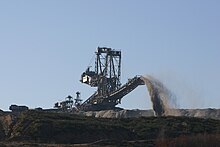Spoil dump

A slag heap , also Hochkippe called, is a heap , which (through the heaping mined settling , tilting or turning over ) of tailings from an open pit is created.
Emergence
During the exploration and operation of an opencast mine, large amounts of overburden, consisting of overburden and intermediate materials , are produced as " deaf " material (mass) .
During ongoing operations, it is normally possible to dump all of the excavated material on the mining side within the open pit on the side from which the raw material has already been extracted. For this purpose, the waste is either by means of conveyor systems over and then transported by means of spreader tilted, or transport and tilting are in a conveyor bridge combined. In some opencast mines, the transport is also carried out by truck or by mine train . The material balance is slightly negative due to the extracted raw material, the opencast mine moves in a horizontal direction, but it almost retains its depth ( depth in terms of mining ) and its volume. At the end of the mining operation, a residual hole remains .
In contrast to ongoing operations, it is often necessary during exploration and in the early phase of operation, before reaching full depth, to move material outside of the open pit. If there is not a residual hole from another, already fully exploited open-cast mine in the vicinity, for whose backfilling the material can be used, material must be tipped in a suitable place in an open field. Over time, a high tip will develop here. If the dump is in an open field outside an opencast mine, it is also called an outside dump . If the dump is tipped within an open pit (this can be the same mine from which the overburden originates or a different one), a high dump can arise if the height of the dump is higher than the level of the surrounding area; here one speaks of an (excessive) inner dump .
Sometimes upturns are only created temporarily and later removed again in order to use the material to fill in remaining holes.
Recultivation and subsequent use
Tilts made up of sandy masses usually have the shape of a table mountain with a large plateau . Thus, after the setting of the material and re-cultivation of the plateau surface is used for agriculture. The side slopes are mostly forested for stabilization and to avoid landslides .
In order to take advantage of the favorable altitude, wind turbines and / or transmission masts have been erected on some of the dumps .
See also
- Mine heaps - heaps from underground mining, especially from hard coal mining
Web links
Individual evidence
- ↑ a b c d Wolfram Pflug (Ed.): Brown coal opencast mining and recultivation . Gabler Wissenschaftsverlage, 1998, ISBN 3-540-60092-2 ( limited preview in Google book search).
- ↑ ZfS Coal, German Democratic Republic (Ed.): Department standard: Terms for open-cast lignite mining: Tipping technology . TGL 100-5173, sheet 9, group 1312 December 30th, 1972 ( bbr-server.de [PDF]).
- ^ Achim Schumacher et al .: Recultivation in the Rhenish lignite mining area. Excursion guide. Part III: Opencast mining technology and power plants . Research Center Recultivation, Jüchen 2011 ( forschungsstellerekultivierung.de [PDF]).
- ↑ Rianne Knoot, Renee de Waal: lignite mining and -rekultivierung at Lausitz: a landscape chronicle. (No longer available online.) LMBV , May 27, 2009, formerly in the original ; Retrieved March 29, 2012 . ( Page no longer available , search in web archives )
- ↑ Dump. In: Mineralienatlas Lexikon. Stefan Schorn u. a., accessed on June 18, 2014 .

